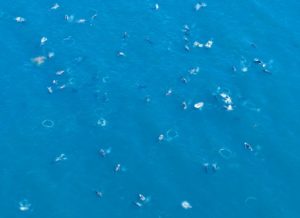Super-groups of up to 200 humpback whales appearing off the coast of South Africa are following changing ocean currents and phytoplanktonblooms,a new study has found.
Researchers at Griffith University were part of an international team led by the University of Cape Town (UTC) which combined satellite observations and a physical ocean model to intricately map the ocean circulation and productivity using chlorophyll levels in the region over the past 10 years in order to understand environmental drivers of these behavioural changes in feeding humpbacks.

Dr Olaf Meynecke.
“While humpback whales in the Southern Hemisphere are known for annual migrations between the summer high-latitude Southern Ocean feeding grounds and the winter mating and calving grounds in subtropical coastal waters, feeding in such dense packs is unprecedented,”said Dr OlafMeynecke, a whale researcher and Manager of the Griffith Whales and Climate Program.
Dr Subhra Prakash Dey from the Department of Oceanography UCT said the formation of whale super-groups in recent years suggested a potential change in oceanographic or ecological characteristics which provide the conditions for this new feeding strategy.
“Through the development of fine scale ocean models our team was able to reveal these oceanographic and ecological changes in the area, theSouthern Benguela Upwelling System (SBUS) off South Africa,that had previously remained hidden,” DrMeyneckesaid.
The unusually large feeding groups of humpback whales in South Africa coincided with the changes in ocean circulation of the region anda higher-than-normal phytoplankton bloom, determined through chlorophyll levels, within one month prior to super-group events.
The study showed thata decrease in the ocean current led to higher retention of the phytoplankton bloom which thewhales responded to by prolonging their feeding in the region over several weeks while ocean productivity was at its highest.
“Understanding the causation leading to these events will allow researchers and the whale watching industry to prepare for the arrival of super-groups of humpback whales at least one month in advance, through the evaluation of chlorophyll from satellite data and ocean models,” explained Dr Dey. 
DrMeyneckesaid that here in Australia the current conditions are very different to those in South Africa, but we have started to see larger groups of feeding humpback whales than in previous years.
“However, unlike in South Africa the large whale pods that have started to show up in Australia only last for a short period of time, but super-groups of humpback whales off the coast of Australia are increasingly likely in the years to come.”
What is driving these changes in ocean currents and productivity that are altering whale behaviour and leading to them migrating together in such massive pods, is not yet fully known.
“There are signs that the major changes that are occurring in the marine environment and ocean circulation are driven by climate change,” DrMeyneckesaid.
“But with only 10 years of data and thelong termcycles that exist in ocean systems we are going to need a longer time series to come to a definitive conclusion.”
The research is part of theWhales & Climate programme, an interdisciplinary approach to understand the impacts of climate change on the recovering population of humpback whales.


